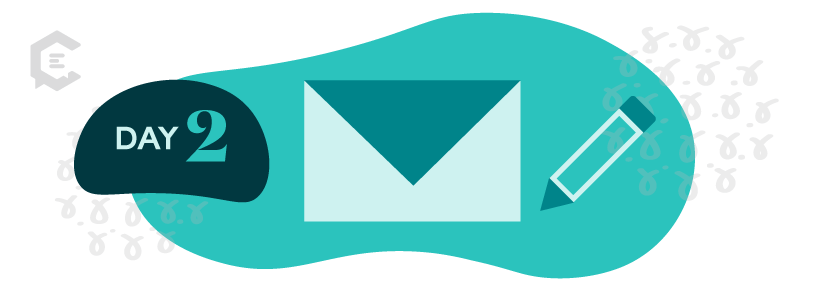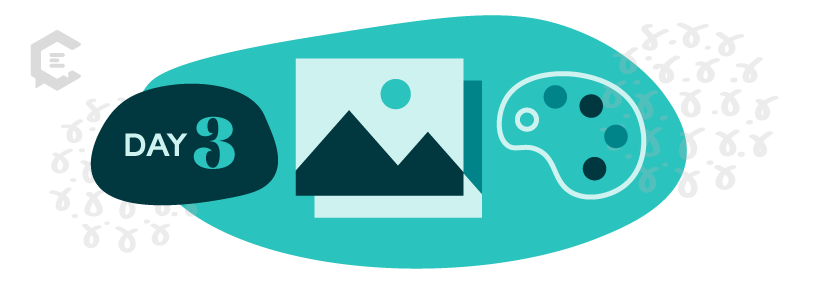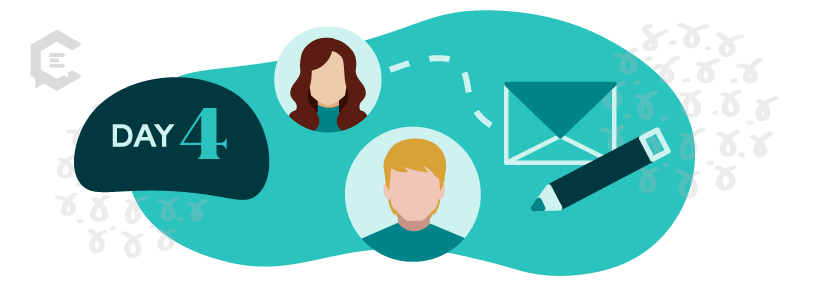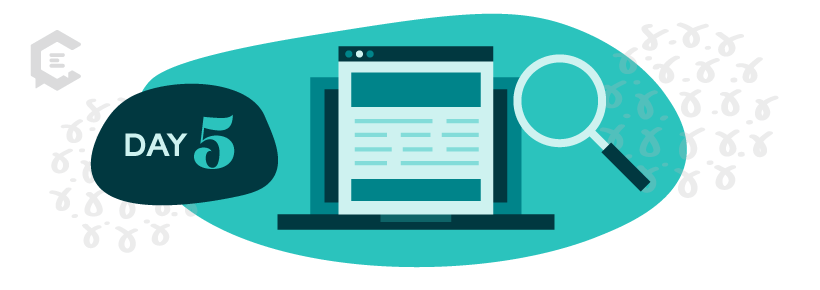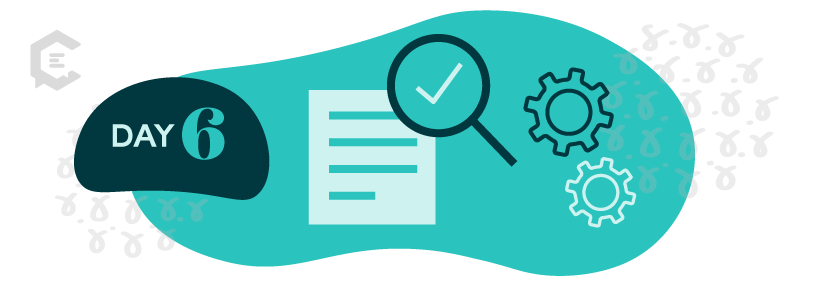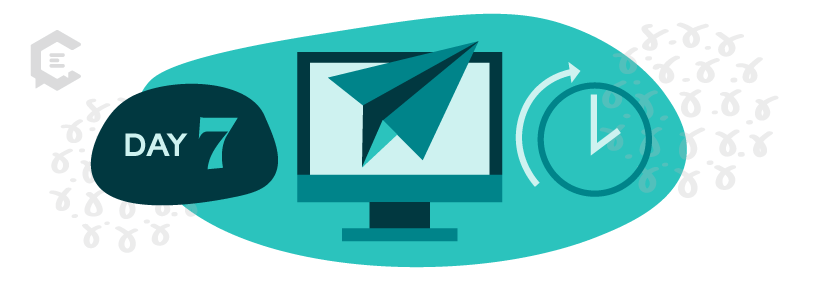Getting started is the hardest part of creating newsletters. How do you plan out when you’ll send—and what should you write? How should it look, and how can you make a company newsletter interesting?
Whether you’re targeting consumers (B2C) or businesses (B2B), there are certain newsletter best practices that you should follow to engage your audience and increase conversions. This seven-day guide will walk you through the process of creating a newsletter, from drafting your content to sending it out into the world.
As every chief marketing officer and content strategist knows, planning an editorial calendar and creating room for revisions and setbacks will save your sanity — and improve your overall performance.
Here’s your guide to creating your email newsletter:
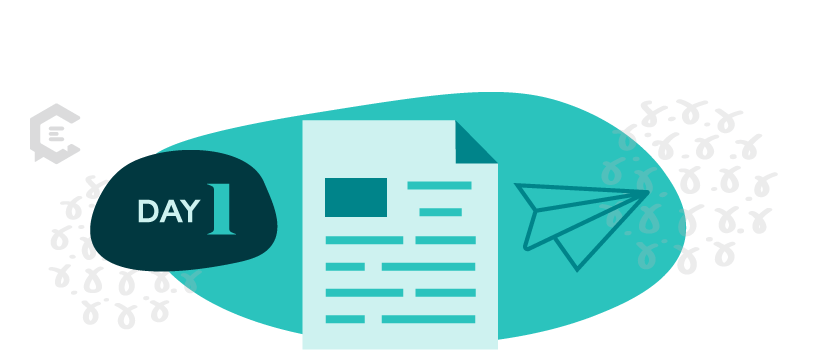
Day one: Create some structure
To prevent yourself from feeling overwhelmed by the task, Zoë Björnson — former marketing lead at About.Me and the current producer at Bynd.com — says your process should always begin with a bit of calendar planning.
Björnson explains your calendar should not only outline what you’re going to write about and when you’ll send it but also the other parts of your process: “make time in your calendar for brainstorming, writing, reviewing, and editing so that you’re not just faced with one big deadline, but rather multiple smaller ones,” she explains.
You can create your plan in Outlook, Evernote, or any other platform that helps you stay focused. Make sure to use your plan to carve out time in your work schedule each day for creating the newsletter.
Here is where time management becomes essential. Björnson stresses the importance of giving each piece of the newsletter space to transform and change throughout the week — from design to subject lines. “Plan out your calendar so you can optimize for each piece of the process,” she adds.
If you follow the structure laid out in this post, you’ll have one mini-deadline each day for seven days.
While you’re in a planning frame of mind, you can also create your newsletter structure. If you already have a newsletter content strategy, that will give you a manageable framework. For example, your content strategy might look like one of these:
- Two recent blog posts, one customer profile, and an external link to a helpful online tool.
- One product tip, one industry update, and one seasonal item.
- Three user tips (with links to more detail), two recent blog posts, and a profile of a new or upcoming product.
- One product tip, one blog post, and one helpful piece of third-party content.
You can see that creating a content strategy makes the job much less daunting. The structure can be flexible, allowing room for new product announcements and other essential items.
Whether you’re using an established framework or starting from scratch, your first step will be to make a list of topics. Keep in mind that the goal of your newsletter is not to share updates about your company — the goal is to serve your readers. Try to provide something unique and useful for them in each email you send.
Here are some company newsletter content ideas that readers will love:
- Industry news that impacts their jobs or lives.
- Trending topics or events.
- Stories about how other customers use your products to improve their lives.
- Forecasts from experts.
- Quick tips to make their lives easier/better.
- Answers to frequently asked questions.
- Brief, entertaining stories.
- Links to online tools.
- User-generated content (ask your users to share photos & stories).
Here are a few employee newsletter content ideas for internal newsletters:
- Upcoming events and holidays.
- Updates on their 401K and other benefit plans.
- Stories about how your company is making customers’ lives better.
- Little-known anecdotes about the company’s history.
- Internal job openings and how to apply for them.
The important thing is to keep your target audience in mind and write content they will be thrilled to receive.
Once you have a list of topics, number them in order of importance. Many people won’t read beyond the first item, so put your most important content at the top. Only your most die-hard fans will read to the bottom (like maybe your mom), so don’t bury anything vital there.
Three or four topics are enough for most newsletters, but you are free to use as many or as few as you like. Experiment and see what feels right.
Pro tip: Many email service providers, like Constant Contact and Mailchimp, let you track which links people click on in your messages. Notice what’s popular, and where your links appear in each newsletter. For example, if no one ever clicks on the links that appear after the fourth paragraph, you might want to send shorter messages.
Day two: Write the content
Now that you’ve mapped out what you’ll be writing about, you’ll be ready to dive right in to the task on day two.
Creating a quiet, distraction-free space to put pen to paper is important. Or, if you’re not the wordsmith, give your writer direction on your newsletter’s voice and mission. Regardless of how you go about it, Björnson advises you to type freely, knowing that you’re not going to hit the send button immediately. She says: “Giving yourself some freedom — hopefully in the shape of a well-designed calendar — will give you more room to write and make mistakes. The most important thing is getting your content out. Then you can focus on refining and tweaking.”
Kimberly Devitt, marketing manager for Corkcicle, also suggests getting comfortable and letting it flow. “Creativity comes in waves. So be sure you’re in the right headspace before you start writing. I’ve found that by straightening up my desk, I am not only clearing my physical space, but I’m also freeing my mind of clutter as well,” she shares.
As a rule of thumb, Björnson suggests creating your content separate from where you’ll distribute it — mainly because technological and human mistakes are bound to happen. This means scribbling in Google Docs and only copying/pasting into HubSpot or another email app (unless you have a seamless integration) once you’re ready to go.
If you have writer’s block, break the writing into tiny chunks. Instead of facing a whole article, think about creating the next item you need — an outline, an intro, a paragraph. Promise yourself the reward of a small break after you’ve finished that item, then tackle the next one.
Some people have the opposite problem — they write too much, too freely. It’s best to keep it simple, short, and sweet. A wall of text isn’t very inviting to the reader. You want to give them short chunks, broken up with images, larger text, and lists or graphics.
For example, many newsletters give each topic just a tabloid-worthy headline, a photo, and a sentence or two of teaser text. Then, they finish with a link to the company blog. That’s a terrific way to keep your newsletter readable. It’s also a smart move if you do any remarketing advertising to your website visitors.
Ask yourself if you can convey some of the information you’d like to cover with an image or photo with a caption. If you want to share a quick statistic or fun fact, use Canva or your newsletter app’s built-in design features to create a graphic.
Pro tip: If you’ve been consistently adding content to your blog all month, you have pre-written content ready to use. Grab the headline, feature image, and first couple of sentences of each blog post and drop them in your newsletter with a link to the complete content for people who want more.
Day three: Map design needs
If you’ve never worked for a magazine, publisher, or newspaper, here’s a quick lesson on copy and layout: They go hand-in-hand, sometimes in unison, and other times, at odds. You can’t have one without the other, and they should complement each other to create a cohesive design that draws the reader into the content.
More often than not, content comes first. Having the content written first lets a graphic artist understand how to use images and design to complement the words. Once the artist can visualize the space for text and the area for photography or other elements, they can roll up their sleeves and get to creating. If you have a small staff, Björnson suggests spending the extra hard-earned dough to hire an experienced designer to take your newsletter from stock-image central to the captivating masterpiece readers will want to open. If your budget doesn’t allow for a designer, she says tools like Canva are great for quick visuals.
Many email service providers come preloaded with templates designed by professionals. The secret to using them well is to keep things simple and not add much to the template design. Remember that white space is a design feature; it makes things easy to digest.
If you’re using a template, consider these questions: How much content are you working with? Do you need one column or two? What’s your most critical piece of content — the headline, the image, or the call-to-action button?
You can also get creative with typefaces. Mixing and matching different fonts can make your newsletter more visually appealing. Just be sure to use no more than two or three different fonts, and limit the number of typefaces to two per newsletter.
However, your design could look amateurish if you get carried away with font styles or colors. Simple black lettering paired with colorful photography and lots of white space is a classic and professional look.
Finally, don’t forget about mobile! With an estimated 81% of email opens taking place on a mobile device, it’s essential to design your newsletter with small screens in mind. That means using a single-column layout, large fonts, and big buttons.
If you’re unsure how your newsletter will look on mobile, use the preview buttons in your newsletter app or run it through an email preview tool like Litmus or Email on Acid. These tools will show you how your email will render across different devices and email clients.
When your content is complete, you’ll need to create a subject line and preview text. Give yourself plenty of time — it’s harder than you think to distill your message into something intriguing enough to convince people to open your email.
Remember to make your reader the focus of your subject line. Instead of saying “News & Updates from Widgets, Inc,” say something like “re: tips to get the most out of your new widget.”Finally, remember why you’re sending out a newsletter in the first place. Do you want people to read your blog, sign up for a course, or check out a product? Don’t forget to invite them with a clear, compelling call to action (CTA). It’s a good idea to position your CTA early in the email in case people don’t read all the way to the bottom. You can close with a reworded version of the same CTA if it feels more appropriate to have it at the end. Multiple calls to action are fine.
Once your content is written, let it rest for a day or two before trying to edit. It’s impossible to do a good job editing copy that you’ve been staring at for hours!
Day four: Collect and update subscribers
While you’re letting your written copy rest, it’s an excellent time to work on your list. Make sure to update the list with any new customers or contacts, and let your social media following know they should sign up if they want to receive the great information you’re about to send out.
Today is also an excellent day to work on growing your subscriber list. Björnson says now is the time to share your “subscribe” link far and wide. While you want to target those in your hopeful audience, to begin with, friends and family will gladly help you reach your number goals by tossing in their email addresses. For the best result possible, she says to keep the process straightforward and remove any roadblocks.
“If your subscription is through a general website, make a separate landing page just for newsletter subscribers to go to and sign up. Also, be sure to set up a confirmation email in your newsletter service so that new subscribers know that they’ve been added to your list, plus a little personality that tells them about you and the cadence of the newsletter so that they know what to expect,” she shares.
Another way to continuously attract subscribers to your website is via subscriber buttons, according to the CEO of The On Switch, Nancy A. Shenker. Make sure your website and social media platforms offer signup buttons for anyone who wants to join your list.
If you segment your list — sending out slightly different material to different groups of subscribers — make sure your signup form lets them opt into the content they want to receive. You may want to send different content to people who are on different steps of the buyer’s journey, for instance, by asking them to check on the signup form whether they’re actively in the market for your products or just curious.
“Make sure you have a good list management system in place, especially if you want different types of readers to get different content. Make sure you also set up ”opt-out” language—especially now that consumers are hyper-sensitive about data privacy,” Shenker advises.
If you want to entice people to join your email list, consider offering some free resources as an incentive. This could be a free PDF guide, an ebook, or a coupon code — anything that will have enough value for your site visitors that they’ll be willing to give you their email address to get it.
Day five: Go through revisions
Don’t think you need a full day to use a fine-tooth comb (and those reading glasses when your eyes are tired from too much screen time) — to go through revisions? Think again, Björnson says. “Content always changes when it’s put into final form, so mold it as needed.”
Here’s the deal: The most thoughtful and engaging newsletters aren’t stellar at their first draft. Especially during your first week of newsletter creation, giving yourself ample time to digest every last line and image will serve your business — and your brand. And hey, don’t be afraid to, well, start over. “Maybe even rewrite it totally, but keep the original just in case! Then, put it into your newsletter service provider and tweak it as necessary.
If you wrote the content, try to have someone else do the editing. But prepare yourself to be open to their feedback — it’s tough, even for professional writers not to feel defensive when someone doesn’t like their choices. If you can, ask a friend or colleague for their help.
If you must proofread your own copy, try reading it aloud. That’s a great way to catch errors and awkward phrasing. You can also use tools like Grammarly — the free version will catch most common mistakes, and the pro version can improve your writing dramatically.
Whoever does the proofreading also needs to test each link in the newsletter.
And finally, don’t forget to proofread the subject line and “from” name in your email service provider! These are important elements that will affect whether or not people open your newsletter.
Day six: Run a test
The test drive is one of the most overlooked steps in email marketing campaigns.
Send out a preview copy of your email to a few chosen staff members for feedback. This will give you a chance to learn about any incompatibilities with different email readers and devices, as well as an opportunity to make sure your copy makes sense to people who haven’t been staring at it for six days.
Then, once you’ve made any necessary changes based on feedback, send out a test email to yourself. This will help you catch any typos or last-minute errors.
“Before sending out your newsletter blast to hundreds, thousands, even millions of email subscribers, it’s essential to test and make sure everything looks as it should — and works as it should, explains Director of Digital Content at Sachs Media, Ashley Perkins. “It will save you a lot of embarrassment and trouble if you catch that last-second typo you previously missed or a broken link in your call-to-action before hitting the ”send” button.”
Day seven: Prepare for takeoff — er, dispatch
Now that you’ve outlined, written, revised, and tested, you’re finally ready to hit that ”send” button. As one last stop-gap effort, Björnson says to preview it, read it through one more time — then schedule the sucker.
Once sent, she says to share a sneak peek of your newsletter on social media. For example, post the subject line or a snippet of the email and a signup link for those who haven’t joined your list. The more you promote it, the more sign-ups you’ll get. But it also gets your subscribers excited to receive your newsletter, which will increase open and click rates.
Expert help is at your fingertips
Want some expert help with your newsletter or blog content? Talk to a friendly content specialist at ClearVoice. We can help you connect with highly-skilled writers, editors, and content strategists.
